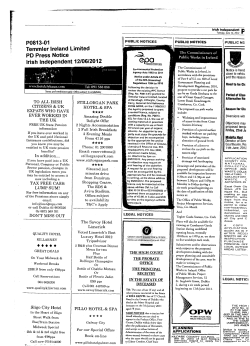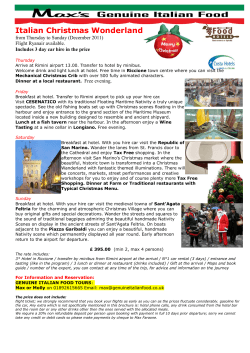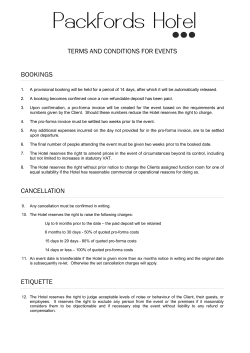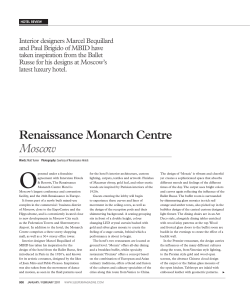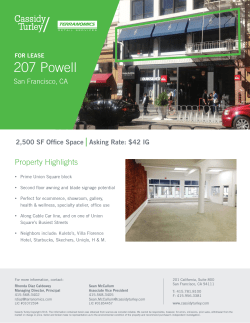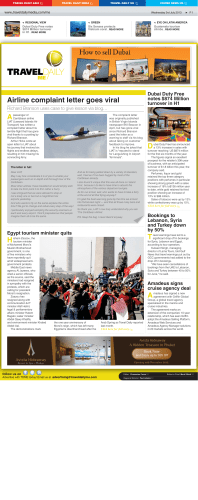
A Abstract frAmework
SAJEMS NS 10 (2007) No 2 223 A framework for successful hotel developments I Venter and CE Cloete Department of Construction Economics, University of Pretoria Abstract Although there are similarities between hotel and other commercial property developments, hotel development has unique characteristics and requires specific management expertise. Hotels are usually ’single-use’ properties, whose primary revenue is generated from a service-based industry. They have a market value directly related to their ability to generate future net income by means of their operations. The essence of successful hotel property development lies in understanding these unique characteristics. Various critical success factors for hotel development are identified in this article, and incorporated into a hotel property development framework, establishing a practical ‘road map’ for successful hotel developments. The validity of the proposed hotel property development framework has been assessed by intensive direct interviews with hotel development professionals. JEL L74 1 Introduction Although there are similarities between hotel and other commercial property developments, the hotel development process has unique and very specific characteristics that are not reflected in the available development frameworks. The present study presents a comprehensive and definitive hotel property development framework, which includes critical success factors and components for hotel development. The critical success factors for hotel development were identified by asking the following questions: • What is a hotel and what is a hotel business? • What are the constituent parts of a hotel business? • What is hotel property development? • What is included in the scope of hotel property development? • What are the criteria for a successful hotel development? 2 Hotel property development and hotel business development The concept hotel development is often used generically to refer to either hotel property development or hotel business development, even to both simultaneously. However, the two concepts should not be confused, as there is a clear distinction between them. Hotel business development applies to the full spectrum of hotel business, from strategic or day-to-day operations to expanding the organisation’s market exposure. Hotel business expansion could be achieved by means of a wide variety of possibilities, such as organisational mergers, existing hotel property purchases, marketing, hotel facility renovations, hotel extensions and new-builds, marketing, branding and business repositioning. It must be noted, however, that, when a hotel business is expanded by means of facilities renovation, extensions or new-builds, organisations venture into hotel property development. Even though hotel business development and hotel property development are two separate 224 entities, they often function as interconnected requirements in the full spectrum of hotel development. This would start with strategic business management at one end of the spectrum and would conclude at the other end with the final handing over of a newly-built hotel to the operator. Hotels are highly complex real-estate projects involving high risk and often consuming a prodigious amount of time, energy and capital. A combination of extreme uncertainty, an extensive and ever-shifting array of market segments and high expectations from the parties involved frequently makes hotel development a more exciting challenging than other kinds of real estate development. A hotel is, in fact, an unusual type of business formula combining a form of real estate with an ongoing serviceorientated business. The successful developer would understand this essential ‘duality’ as both real estate and business (Baltin et al., 1999). The hotel market is extremely volatile (Kennedy, 1999). An analysis of 25 regional hotels in the United Kingdom over 20 years, encompassing two periods of recession (1981 and 1993) and two periods of peak performance (1990 and 1998), indicate sustained real growth in profitability. Trading profits are shown to have increased between 2.9 and 3.5 per cent in real terms over the 20-year period. However, despite this, there is evidence of short-term volatility in earnings performance (Graham, 2001). Not only do economic trends and cycles impact on a country’s hotel market stability, but also political, technological, socio-economic and other uncontrollable factors. For example, the tourism and hotel industries are key foreign currency earners for Egypt, but there is always the danger that the industries could be severely harmed by terrorism. This occurred after the Luxor massacre in November 1997 (Butter, 1997), and after the terrorist attack in the World Trade Centre on 11 September 2001. The factors affecting the macro-economic environment have a direct but delayed impact on the hotel industry and business environments. This in turn influences hotel revenues and profitability, impacting negatively on the feasibility of hotel developments. When occupancies begin to SAJEMS NS 10 (2007) No 2 decline, the average daily revenue (ADR) and revenue per available room (RevPAR), two key measures of market performance for the hotel industry, are threatened. Once ADR and RevPAR begin to fall, hotels typically lower their room rates in an attempt to recover lost revenue. Unfortunately, more often than not, this has a negative effect on profitability, rendering the market less attractive to investors. Proposals for new hotels require feasibility studies to measure market demand and to assess whether a proposed project is economically viable. In order to avoid the problems of overbuilding, new studies should focus on one major question (Turkel, 2000): • Is there a market for this hotel in this location? If there is, the following detailed questions should be asked: – Where is that market? – How large is it? – What are its needs? – How is it currently being served? – What share can be captured? Turkel (2000) further recommends that, in order to make feasibility studies more realistic, there should be a fresh look at the methodology, not overlooking the following important issues: • Occupancy and average daily rate projections should reflect the real volatility in the marketplace. • There should be a genuine analysis of the tradeoffs inherent in the yield management decisions as they pertain to both market penetration and revenue maximisation. • There should be a serious analysis of the relative profitability of the food and beverage outlets beyond the misleading departmental profit margins provided by the Uniform System of Accounts. • The feasibility study analysis should enable owners to decide whether to manage, lease or franchise the food outlets. While location remains the single most important factor affecting investment and lending decisions, intangible assets like brand SAJEMS NS 10 (2007) No 2 and human capital are gaining ground on tangible assets as an important key to hotel property valuations in the new economy. The hotel industry has always been a house divided, because companies act in the dual capacities of real estate owners and managers of enterprises, seeking capital to support both the property and the operational sides of the business. At the same time, management has to allocate capital between physical assets (the hotels they own and operate) and intangible assets (customers, the brands they own, the people they employ, the technology they use and the alliances they form) (Cline, 2001). A hotel is an establishment that provides transient lodging for the public and often meals and entertainment. Factors affecting the success or failures of a hotel development vary according to its primary function (Pyhrr et al., 1989: 871). This, and the frequent, often daily, turnover of guests means that hotels demand more continuous management than most other categories of space. Hotel management includes food service and entertainment, and involves also the typical property-management functions. The lease period is very short and, if the hotel is to be successful, management must find tenants (guests) for spaces that are vacated daily, stressing the importance of hotel marketing (Wurtzebach et al., 1995). 3 Hotel service product Powers (1996: 215) describes the hotel service product as a bundle of features and benefits. It has three elements: a core benefit, an essential facilitating service and a competitive supporting service. 3.1 Core benefit The core benefit is the generic function the service product provided to the guest. For the operation it is the ‘reason for being in the market’. This could be a night’s lodging, entertainment, relaxation, nourishment and a social experience. 225 3.2 Facilitating services Facilitating services are absolutely essential to the operation. If the facilitating services are absent, it will be impossible to deliver the core benefits. For example, the absence of a front desk or housekeeping in a hotel would make its operation impossible. In a restaurant, the kitchen provides a facilitating service without which the operation would have to shut down. 3.3 Supporting services Supporting services are not essential to providing the core benefit, but they are essential to marketing the operation. Supporting services are used to differentiate between the operation and its competitors. For instance, a restaurant is not a necessary component of a hotel, but could be used to distinguish one property from another. One of the most powerful supporting services in lodging is its reservation service. The key to the successful operation of a hotel is providing an experience that truly satisfies the guest (Crowne Plaza Standards Manual, 2000). To accomplish this, the hotel or resort’s management and staff should focus on the guests’ perspective of what is important and deliver on those expectations. The customer’s viewpoint includes elements from reservations through check-out. The initial impression is gained from reservations and advance deposits. The actual experience begins with arrivals, the kerbside/door service, valet parking and front desk registration. Facilities like background music, the bell service, telecommunications, voice-mail and messaging, telephone sets, the gift shop, complimentary tea and coffee and complimentary newspapers are conducive to the guests’ enjoyment and sense of being cared for. As far as physical comfort is concerned, the guest rooms, bathroom amenities and in-room dining are important. Practicalities like laundry services, housekeeping, lost and found, security and maintenance create an air of convenience for guests. On the entertainment or relaxation side, they are interested in primary restaurants, secondary restaurants, the lounge, bars, the pool, sports activities and the fitness centre. 226 SAJEMS NS 10 (2007) No 2 Figure 1 The hotel (product) concept (Source: Diagrammatic interpretation of powers, 1996) 4 Hotel segmentation Segmentation is a three-step process (Kotler et al., 1999). The first step in this process is market segmentation, dividing a market into distinct groups of buyers who might require separate products and/or marketing mixes. One of the most frequently-used methods for segmenting a market has been demographic segmentation, which consists of dividing the market into groups based on demographic variables like age, gender, family lifecycle, income, occupation, education, religion, race and nationality. One reason for the popularity of this method is that consumer needs, wants and usage rates correlate closely with demographic variables. Another is that demographic variables are easier to measure than most other types of variables. Other variables, for example, geographic, geo-demographic, psychographic and behaviourist variables, can be used to segment markets. The second step in the segmentation process is market targeting, which is the evaluation of each segment’s attractiveness and then selecting one or more of the market segments. Marketers identify the segments and then look for the segments that would be the most profitable for the organisation in the long term. The third step is market positioning, comprising the development of a competitive position and an appropriate marketing mix for a product. Once a company has chosen its target market segments, it must decide what positions to occupy in those segments. The positioning task consists of three steps: • identifying a set of possible competitive advantages on which to build a position, • selecting the right competitive advantages and effective communication, and • delivering the chosen position to a carefully selected target market. Hotel developers should consider the target market that the hotel expects to serve. The target market will serve as a guide for planning the physical structure and amenities in the hotel, which are derived from guest profiles, the hotel's location, the budget and the brand status (Baltin & Cole, 1995). Hotel organisations approach market segmentation in a manner similar to the one described above (Kotler et al., 1999). McDonald and Payne (1998: 81) categorise segmentation as falling under the two broad headings of customer characteristics and customer responses. In other words, Who are our customers? and Why do they behave as they do? 5 Hotel property development The development process can be defined as the act of bringing an idea or a concept to successful fruition in bricks and mortar (space), with associated services. It is a complex process, requiring the co-ordinated expertise of a number of professionals. On the investment side, financial sources must be attracted by the SAJEMS NS 10 (2007) No 2 promise of sharing the cash flow generated by development in a manner that properly balances risk and return. The physical construction of the project requires co-ordination of architects, engineers and contractors. The public sector, especially local government, must approve the legality of the development in terms of zoning and building codes, amongst other things. Ultimately, and most importantly, user needs must be satisfied. This requires the developer to identify a market segment in which sufficient market demand will exist for the type of space to be created. The idea for a hotel project could originate in many quarters (Baltin, 1999). Generally, one or more of the following parties initiates the development programme: an equity investor, an investment group, an institutional investor, or an investment fund; a property owner recognising a development opportunity; a developer seeking an opportunity, interested in expanding its real estate portfolio, or needing a cash-producing investment; a developer needing a hotel as a component of a mixed-use development; a hotel development or management company seeking to expand its product into new markets; a local non-profit, tax-exempt development corporation; a public or quasi-public agency like a redevelopment authority, a planning department, a development corporation, or a tourism authority; a citizens’ advisory committee, or special community task force; a special-interest group, organisation of local businesses, or merchants’ association; or the owner/developer of a sports or entertainment facility. The development of a hotel takes a long time, sometimes years. It should be marketdriven, based on the principle that hotels meet the development objectives of investors and owners by providing the type and quality of products and services that the market desires. The development process, therefore, links the investor/owner, the developer and the operator with the public that is to be served. 227 5.1 Hotel development process The real estate development process consists of eight stages, which are typical but not necessarily followed in all cases: (Wurtzebach et al., 1995: 652): 1) idea / inception 2) idea refinement 3) feasibility 4) contract negotiations 5) commitment point 6) construction 7) initiation of operations 8) asset management over time. Five distinct and generally sequential phases can be distinguished when a hotel is being developed (Baltin, 1999: 30): 1) development planning 2) assembly of the development team 3) feasibility analysis 4) project implementation 5) initial marketing and operations. Inter-Continental Hotels (1996) defines the following five key development phases for their hotel developments: Phase 1: Design concept Phase 2: Design development Phase 3: Contract documentation Phase 4: Construction period Phase 5: Post-construction period. It is clear from the above that different approaches and viewpoints of property development exist. In fact, the development process is not a rigid but a flexible one that reflects a particular situation. Although the characteristics and requirements for hotel property development differ in many respects from those of other types of real estate, there are also many similarities. The models referred to above are combined in a generic hotel property development process illustrated in Figure 2. 228 SAJEMS NS 10 (2007) No 2 Figure 2 Property development process SAJEMS NS 10 (2007) No 2 5.2 Hotel development strategy The starting point of all major business decisions should be the organisation’s mission statement, with its associated goals. The mission of any organisation should articulate the vision and give a sense of direction (Brookes, 1999; Pearce & Robinson, 1994). From the hotel organisation’s mission, objectives and strategies, the hotel development department should develop its own specific task-orientated mission statement, objectives, strategies and control procedures. Ransley and Ingram (2000) suggest that those concerned with preparing a development strategy need to know where the business is going, should develop a sound knowledge of the product/brand, and should be aware of the characteristics of the customer profiles. The objectives should be clearly articulated at the start of a plan as part of a strategic vision and mission. In some instances, the plan can be for the corporate entity as a whole, while in other cases there may be an individual plan for each project (which could then be consolidated into the corporate plan). A development strategy is a statement of how an organisation intends reaching its growth objectives; in the hotel industry this often means the construction of new units. Clear criteria must be set for the hotel building, the facilities and other considerations, such as the site. Development considerations would include the site size, the cost per room, total development costs, and some general guidelines that could help with the rapid appraisal of potential new projects. Finally, a set of locational criteria should be developed to ensure that the hotel is constructed in suitable contexts. This shows how a clear development strategy can assist in the proliferation of a hotel brand (Ransley & Ingram, 2000). The development strategy will define and analyse in considerable detail the following internal and external questions: Internal: • What are the objectives of the organisation, its shareholders and its stakeholders? 229 • What brands, products or services are being supplied? How could they be described? • What are the strengths and weaknesses of the organisation? • What are the opportunities and threats for the brand? • What is the pricing policy? How does it relate to price sensitivity in the marketplace? External: • Who is the competition? What is known about them and their strategies? • How could a competitive advantage be gained? • Who are our customers? What is known about them and their characteristics or buying habits? Are these characteristics likely to change? If so, how and why? • Are there any external influences that are likely to affect the ‘marketplace’, including political, environmental, economic or legislative issues? An example of the objectives defined in a hotel group’s development plan is that of Trust House Forte’s Post House Hotels, United Kingdom (Ransley & Ingram, 2000: 26): • Expand the group by adding three new hotels a year for a five-year period. • Take the brand ultimately into Europe from a strong UK positioning. • Become the preferred hotel group of choice for the business and leisure traveller operating in the mid-price market. • Maintain value for money. • Sustain brand loyalty and increase market share. • Provide an above-average return on investment. • Develop an economic model for the evaluation of opportunities. Finally, branding is an increasingly popular method of marketing and developing hotels, because it communicates a consistent and understandable message to the potential guest. 230 5.3 Hotel development criteria The most common pitfalls (Echavarren, 2001) when developing a project are: • Lack of vision and objectives for the project: the project arises on impulse and its strategy and objectives are not clearly defined • Unrealistic objectives: estimated savings or expected returns are not calculated properly • Inadequate project specifications, requirements are not calculated and areas are undefined. The development planning of a property starts with setting overall objectives. The central problem with many unsuccessful hotels is that the inexperienced party’s original inspiration is never consolidated with sound business planning. Some developers and investors attempt a project without considering the level of their commitment, their ability to finance the project, or their expectations of financial gain. Developers building a hotel in a mixed-use development often fail to make these critical assessments. Developers who perceive an overriding need for a hotel often ignore good planning practice. To establish a property’s development objectives, the following initial questions should be addressed (Baltin et al., 1999: 30): ‘Financial objectives: Is long-term value appreciation an objective? Is the creation of an operating entity an objective? Are development profits being sought? What are the priorities of the developer regarding these goals? How much equity can the development partners invest? Can the developer obtain financing for a project of this magnitude? What return on investment will be acceptable to the developers and the potential financial partners? How much time, money and resources can be committed by all parties involved? Development objectives: Does the site present development constraints? Development opportunities? Is the site free of toxic contamination? Are the surrounding land uses (existing and proposed) compatible with SAJEMS NS 10 (2007) No 2 a hotel? Who will serve as the developer? How familiar is the developer with the hotel development process? Is making a special statement an objective (through distinctive design, for example)? Will government policies encourage or discourage development of the site? Are appropriate public financing incentives available? How will the public react to the proposed development? How long will the necessary approval processes take? Operational objectives: What type of hotel management will be best - franchise, affiliate, or owner/manager? Can the owner/developer manage the hotel, or will the services of a professional hotel operator be required? What level of owner/developer involvement in the hotel is desirable or even possible?’ These objectives must coordinate with realworld conditions. Initial planning therefore has to identify any conditions and activities that could have a positive or negative impact on the hotel’s development. Important data must be assembled at this early stage and consultations initiated with experts and potential participants (public agency officials, lenders, developers, syndicates, bankers, hotel operators, and architects). Failure to do this will limit the developer’s chances of putting together an economically feasible development programme. The developer must find answers to some detailed questions on development issues. All the elements that could affect the development of the hotel product and the owner’s requirements should be considered. During the 1980s, the Trust House Forte’s Post House chain, after extensive research, formulated a development plan and a strategy for future business expansion. The development plan included criteria for the hotel, the site and other considerations (Ransley & Ingram, 2000). 5.4 Requirements for successful hotel property development It is imperative for a hotel developer or hotel organisation wanting to develop a hotel, to SAJEMS NS 10 (2007) No 2 establish an overarching comprehension of a wide, but specific range of hotel operational and development factors. Success requirements, according to Lawson (1997: 1), could generally be grouped under the following five headings: • • • • • Marketing: an increasing and unsatisfied demand for accommodation stemming from the tourism, recreation and business attractions of a locality. attract the hotel guest. The successfully-targeted development will focus on the market objectives it is supposed to achieve. ‘A targeted design begins not with colour swatches, but with an analysis of all the information bearing on the hotel’s market position, which includes the following’: • competition, • available market, Economics: the state of the economy and financial inducements or constraints that may favour or restrict investment. • targeted market segment, by purpose of visit, • guest profiles using psychographics, Location: availability of appropriate sites with adequate infra-structural services and opportunities for development. • budgetary considerations, • consideration of potential amenities, facilities configuration and aesthetics, Enterprise: correct interpretation of requirements and entrepreneurial organisation of the necessary finance and expertise to successfully implement a project. • management configuration and goals, • brand standards, strengths and constraints, and • marketing and distribution capabilities. Planning and design: careful planning and design of facilities to create an attractive hotel that will satisfy the marketing, functional and financial criteria. Targeted design requires as much data as possible about the potential guest, using both guest questionnaires and interviews with the hotel sales, food and beverage, housekeeping and management staff. The manager, market consultant, designer and owner can then collaborate on a focused design that will include not only decor, but also facilities configuration, pricing, amenities and marketing strategy (Baltin & Cole, 1995). From a hotel operator/developer’s pointof-view, Sun International defines its hotel development success criteria as (McGee, 2002): According to Cloete (1998: 116), success factors for property developments that are relatively controllable, even if only in the sense that the developer is able to choose between alternatives, are: • type and quality of property, • factors regarding location, • price, interest and costs, and • time and marketing There are also a number of other factors over which an investor has less or no control: • international, national and local economic, political and social factors, • national and local government regulations (legislation, town planning and building regulations), and • 231 short- and long-term business confidence. Baltin and Cole (1995: 36) caution against designers who often incorrectly do what their clients think is correct, rather than what will • location, • accessibility (for guests, staff and suppliers), • flexibility of design (combination of room types, such as suites, king-size, doubledouble and interconnecting), • efficiency of design, • marketing, • branding, • staffing (skills, training and experience), • standards (education, implementation and consistency of standards), and • government requirements (taxes, duties, crime and policies). 232 5.5 Establishing the hotel property development framework The aim of the study is to develop and validate a hotel property development framework. Hotel developments should subscribe to a mix of critical success factors, which should be incorporated during the development process. The following critical success factors for hotel developments were identified: • operational strategic direction and market understanding, • branding and marketing, • operational management and staff – skills, training and experience, • operational and construction standards – education, implementation and consistency of standards, • national and local government regulations – taxes, duties, policies, legislation, town planning and building regulations, • site location, • accessibility – for guests, staff and suppliers, • feasibility – financial, market, physical, macro-environment, • design efficiency – meeting budget, operational efficiency and guest satisfaction, • development of strategic and project objectives, • development team – team leader, executive management, key operational staff, consultants, and advisors, and • contractor – cost, time, quality, experience, resources, capability and attitude. In addition to identifying the critical success factors for hotel development, they had to combine in a sequence and at specific junctures to form a practical and definitive hotel propertydevelopment framework. In solution, two hotel property-development frameworks were developed, first for hotel operators and second for hotel property developers. The hotel development framework for a hotel operator is included in figure 3(a), and that for a hotel property developer in figure 3(b). SAJEMS NS 10 (2007) No 2 The development frameworks are broadly similar, but slightly adjusted to suit the different development viewpoints of either a hotel operator or a hotel property developer. 5.6 Validation of the proposed frameworks The research methodology could be broadly categorised as a content analysis-type empirical study (Mouton, 2001), in which secondary textual data was analysed, and critical factors identified. These were in turn included in a visual and sequential framework that was validated in practice by means of intensive interviews with key hotel development managers of leading hotel operators and a hotel property developer. Owing to the logistical requirements of intensive interviews, the interviews were limited to hotel operators and hotel property developers based in the Republic of South Africa, operating or developing properties in the southern African region. The interviews were conducted on a personal (face-to-face) basis, were guided by questionnaires and developed as extensions of the hotel development framework for a hotel operator and hotel development framework for a hotel property developer. SAJEMS NS 10 (2007) No 2 233 (Source: Culmination of views in the literature review) Illustration 3(a) Hotel development framework for a hotel operator 234 SAJEMS NS 10 (2007) No 2 (Source: Culmination of views in the literature review) Illustration 3(b) Hotel development framework for a hotel property developer SAJEMS NS 10 (2007) No 2 The hotel operators interviewed were: • Global Resorts & Casinos, represented by the development director • Legacy Hotels & Resorts, represented by the group operations director • Sun International, represented by the manager of developments • Southern Sun Hotels, represented by the development director Two hotel property developers were approached, but only one developer (Kondotel) was willing to participate and furnish information on hotel property development.. 5.7 Research interviewee feedback All four hotel operators interviewed confirmed that, in principle, the process identified in the hotel development framework for a hotel operator is correct, and is crucial to the process of establishing successful hotel developments. However, it transpired clearly that the hotel development framework for a hotel operator could not be applied in a fixed or rigid manner, but would have to be adapted to suit the particular scenario presented to develop a specific hotel property. In practice, depending on project requirements and characteristics, some of the framework components are omitted purely because they are not required. An example, according to Shayler (2002), is the construction of the Portswood Hotel at Cape Town’s Waterfront, where hardly any market research was carried out. Legacy Hotels & Resorts made the decision to construct the Portswood Hotel based on the fact that their adjacent Commodore Hotel’s occupancy was averaging at 85 per cent, which justified the construction of an additional hotel in close proximity. In addition to omitting some stages when necessary, Randall (2002) and Forrer (2002) advised that some of the individually-identified stages of the hotel development framework for a hotel operator should be combined into a single step. An example already mentioned is the development strategy process and project objectives process, which could be addressed as one stage. 235 There was also comment about the extent of detail contained in the hotel development framework for a hotel operator. Forrer (2002), Randall (2002) and Shayler (2002) all confirmed that, in practice, the hotel development process would seldom, if ever, contain the same extent of detail as is depicted in the hotel development framework. Owing to the fact that only one hotel property developer (Kondotel) was interviewed, the hotel development framework for a hotel property developer could not be substantiated. Valuable hotel development information was, nevertheless, supplied and was incorporated into the hotel development framework for a hotel developer. It is important to highlight, as explained by both Forrer (2002) and Randall (2002), that a typical hotel development process within the southern African context will almost always be driven or initiated from the perspective of an executive hotel operational, as opposed to a property development perspective. This is in contrast to the USA or Europe, where specialist hotel property developers often initiate new hotel developments. 6 Conclusions and recommendations Five major South African hotel development professionals confirmed that the proposed hotel development framework for a hotel operator constitutes a practical and valid development framework. In addition, the development professional confirmed that the hotel development framework contains essential and critical hotel property development stages and success factors required if a hotel development is to be successful. Critical success factors for hotel development were identified and incorporated into development frameworks for hotel operators and hotel developers. The primary objective of the study was to test the validity of the hotel property development framework, which included the following stages and components: • strategic analysis, 236 • development audit, • development strategy and criteria, • project objectives, and • hotel property development process, including macro-environmental, market, physical and financial feasibility analyses. Key points identified while researching the distinguishing success factors of hotel development were: 1 Hotel business combines three essential components – real estate, hotel operation, and FFE (furniture, fittings and equipment). 2 Hotel operation is, in essence, a service-type business with an essential mix of tangible and intangible elements. 3 Hotel property development deals primarily with the tangible elements, but cannot successfully achieve its objective without a comprehensive understanding of the intangible service elements. 4 Hotel property development is comprised of 12 sequential phases. 5 Strategic hotel development is an integral aspect of establishing a successful hotel. 6 Clear development criteria and project objectives must be defined and implemented. 7 Project feasibility comprises not only the financial considerations, but also macroenvironmental, physical, and market feasibilities. 8 Project financial feasibility comprises five primary considerations. 9 Total development cost includes five clearlydefined cost categories. 10 The project team is critical to establishing a successful hotel; hence selection of the correct members is crucial. 11 When appointing contractors to execute the work, serious consideration should be given to their capacity, experience, trackrecord and current work load, and then, finally, at their tender price, to perform the work successfully. SAJEMS NS 10 (2007) No 2 Hotel development success requirements could be summarised as a combination of marketing, economics, location, enterprise, professional team, planning and design, and construction factors. Hotel property development offers ample opportunity for further research, It is recommended that the topic of hotel property development be further investigated, with special emphasis on the validation of the critical success factors for hotel development in practice and the establishment of an industry barometer for hotel success. References 1 ANDERSON HOSPITALITY CONSULTANTS, Hospitality 2000: The Capital. 2 BALTIN, B. & COLE, J. (1995) “Renovating to a target market”, Lodging Hospitality, 51(8): 3. 3 BALTIN, B. et al. (1999) Hotel Development, The Urban Land Institute: Washington. 4 BOWEN, J.T. (1998) “Market segmentation in hospitality research: No longer a sequential process”, International Journal of Contemporary Hospitality Management, 10(7): 289-296. 5 BUSINESS DAY (2001) “Breaking down barriers to international visitors”, (Sept. 21), Business Day (South Africa).[Online] Accessed 21 September from http://www.businessday.co.za. 6 BROOKES, M. (1999) “Strategic Marketing”, Module in the Diploma in Management Studies (Hospitality), Oxford Brookes University School of Hotel and Restaurant Management. 7 BUTTER, D. (1997) “Egypt: Tourism minister launches damage limitation drive after Tahrir deaths”, MEED Middle East Economic Digest, 41(40), 9(1). 8 CLINE, R.S (2001) “Global survey profiles industry’s sources and uses of funds”, Andersen Hospitality Consulting Services. [Online]. Accessed September 2001 www: http://www.andersen.com. 9 CLOETE, C.E. (1998) Property Development 1, South African National Property Education Committee: Sandton. 10 CROWNE PLAZA STANDARDS MANUAL (2000) Bass Hotels and Resorts: Brussels. 11 ECHAVARREN, E. (2001) “Real estate project review”. Corporate Finance Quarterly Report Enero 2001. [Online]. Accessed November 2001 from http://www.andersen/europe.com. 12 FORRER, J.E. (2002) [Interview with Mr. Jeff Forrer, Development Director, Global Resorts and Casinos] Johannesburg, 19 June 2002. SAJEMS NS 10 (2007) No 2 13 GRAHAM, I. “Extended investment in UK hotels produces above average returns”, Arthur Andersen Real Estate Hospitality & Services Group [Online]. Accessed October 2001 from the World Wide Web: http://www.andersen/europe. com. 14 HILBERATH, T. (2001) [Interview with Mr. Thomas Hilberath, General Manager, InterContinental Hotels] Cairo, Egypt, 28 September 2001. 15 INTER-CONTINENTAL HOTEL (1996) Inter-Continental Hotel Architectural and Engineering Specifications, Inter-Continental Hotel Corporation. 16 JONES LANG LASALLE HOTELS (2001) “The impact of the September 11, 2001, terrorist attack on the US hotel real estate market” [Online]. Accessed October 2001 from http://www. joneslanglasallehotels.com. 17 KENNEDY, K. (1999) “Hotel construction market reaches cycle’s peak”, FDM, Furniture Design & Manufacturing, 71(3): 8, Chicago. 18 KOTLER, P.; BOWEN, J.T. & MAKENS, J.C. (1999) Marketing for Hospitality and Tourism (2nd ed.) Prentice-Hall Publishers: Upper Saddle River. 19 KRUGER, J (2002) [Interview with Mr. Jan Kruger, CEO of Kondotel] Johannesburg, 24 October 2002. 20 LAWSON, F. (1997) Hotels & Resorts: Planning, Design and Refurbishment, Architectural Press, Butterworth Heinemann Publishers: London. 21 LOURENS, M. (2002) [Interview with Mrs Marlien Lourens, Senior Consultant, Grant Thornton Kessel Feinstein Tourism, Hospitality & Leisure Specialists] Johannesburg, 29 April 2002. 22 MCDONALD, M. & PAYNE, A. (1998) Marketing Planning for Services, Butterworth Heinemann Publishers: Oxford. 23 MCGEE, J. (2002) [Interview with Mr James McGee, Manager of Developments, Sun International] Johannesburg, 21 June 2002. 24 MOUTON, J. (2001) How to Succeed in Your Masters and Doctoral Studies: A South African Guide and Resource Book, Van Schaik Publishers: Pretoria. 25 NEEB, P. (2002) [Interview with Mr. Peter Neeb, Director, McIntosh, Latilla, Carrier & Laing Quantity Surveyors and Construction Consultants] Johannesburg, 22 April 2002. 26 PEARCE, J.A. & ROBINSON, R.B. (1994) Formulation, Implementation and Control of Competitive Strategy, Richard Irvin Incorporated: Boston. 237 27 POWERS, T. (1996) Marketing Hospitality (2nd ed.) John Wiley: New York. 28 PYHRR, S.A.; COOPER, J.R.; WOFFORD, L.E; KAPPLIN, S.D. & LAPIDES, P.D. (1989) Real Estate Investment: Strategy, Analysis, Decision (5th ed.) John Wiley: New York. 29 RALEIGH, L.E. & ROGINSKY, R.J. (1999) Hotel Investments: Issues and Perspectives (2nd ed.) Lansing: Educational Institute - American Hotel and Motel Association. 30 RANDALL, K (2002) [Interview with Mr. Keith Randall, Development Director, Southern Sun Hotels] Johannesburg, 12 June 2002. 31 RANSLEY, J. & Ingram, I. (2000) Developing Hospitality Properties and Facilities, ButterworthHeinemann: Oxford. 32 RUSHMORE, S. & BAUM, E. (2001) Hotels and Motels: Valuations and Market Studies, Appraisal Institute: Illinois. 33 SCHWANKE, D. (1997) Resort Development Handbook, The Urban Land Institute: Washington. 34 SHAYLER, I. (2002) [Interview with Mr Ian Shayler, Group Operations Director, Legacy Hotels & Resorts] Johannesburg, 25 October 2002. 35 TURKEL, S. (2000) “A fresh look at feasibility studies”, International Society of Hotel Consultants. [Online]. Accessed September 2001 from http:// www.ishc.com. 36 WURZEBACH, C.H.; MILES, M.E. & CANNON, S.E. (1995) Modern Real Estate (5th ed.) Wiley: New York.
© Copyright 2026
